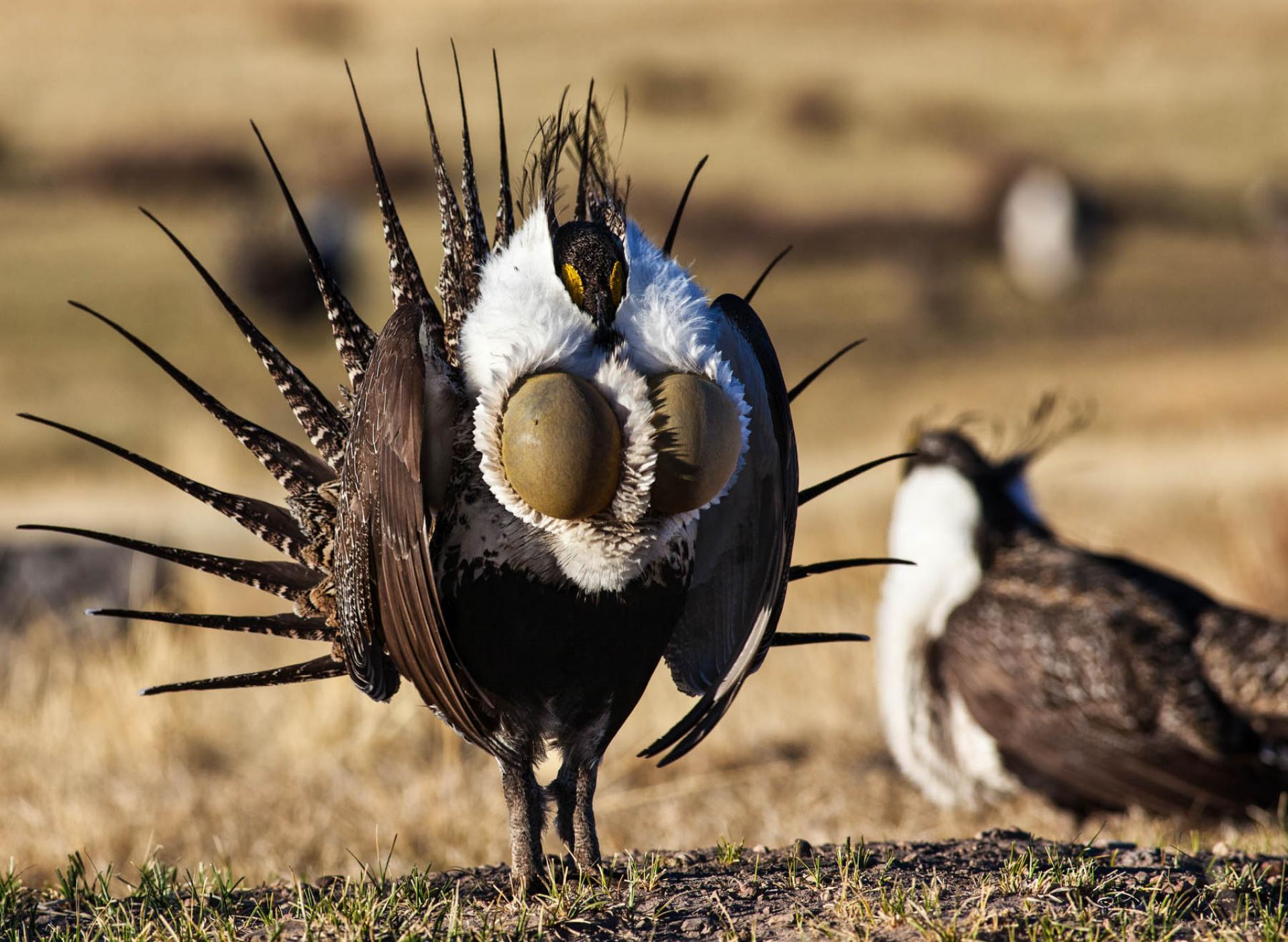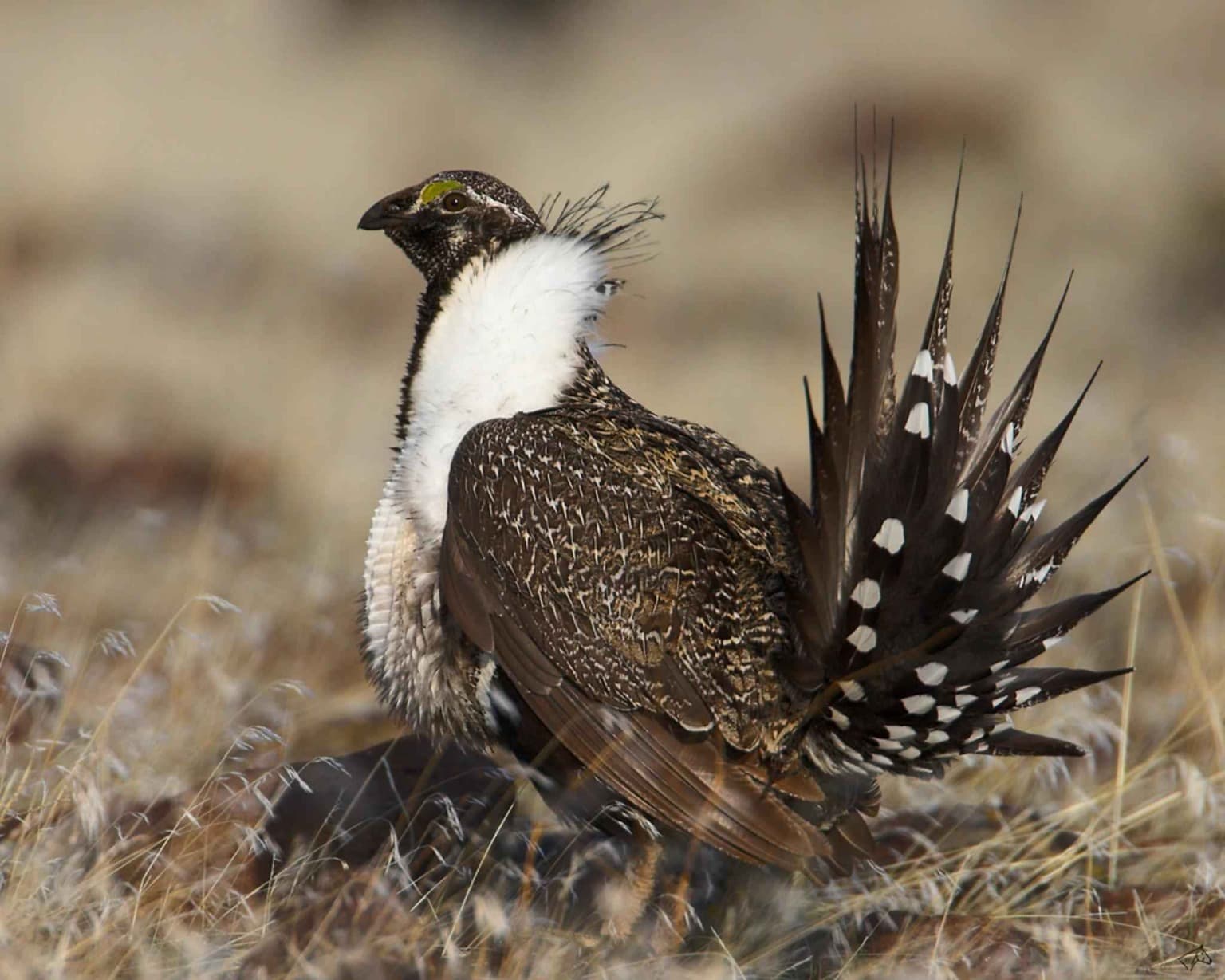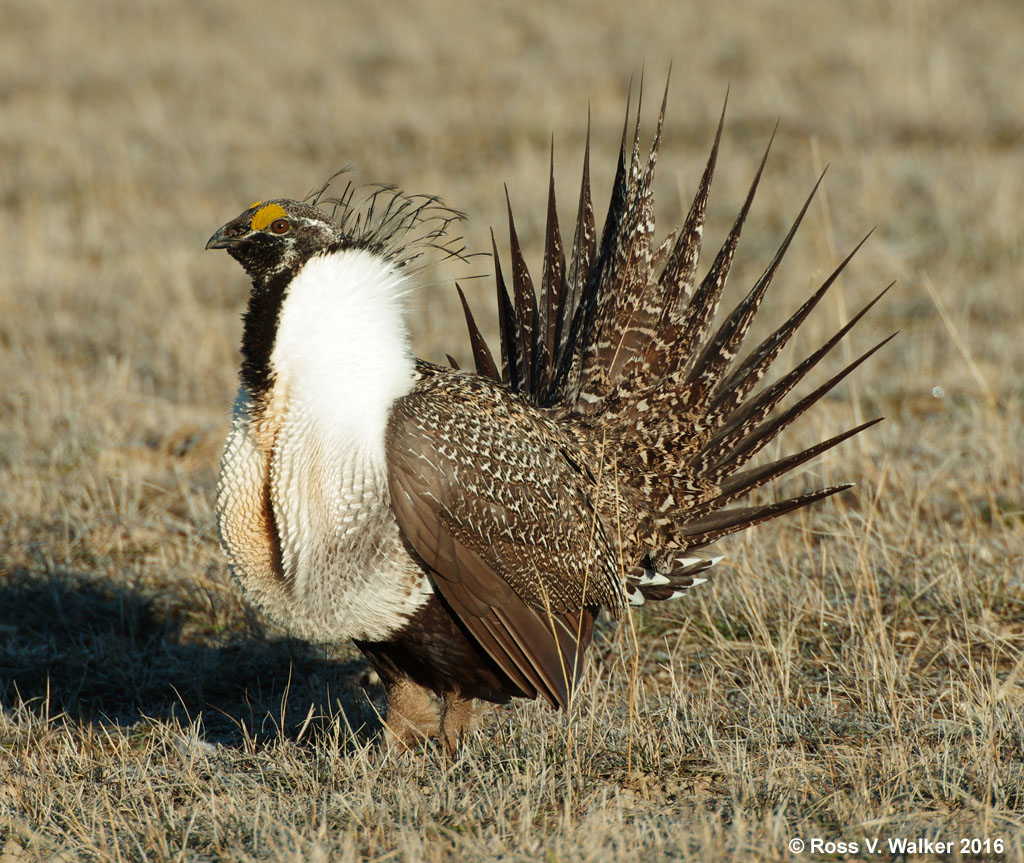Sage Grouse - Guardians Of The Western Wilds
Imagine a bird that seems to carry the very spirit of the American West on its wings, a creature whose life is tied so deeply to a particular plant that its very name reflects this bond. That, you know, is the sage grouse. These remarkable birds, with their distinctive plumage and fascinating courtship rituals, are truly a sight to behold, a living piece of the vast, open country. They represent something quite special, a wildness that many of us, I think, often long for. Their presence signals a healthy landscape, a place where nature still holds sway in a very real sense.
These birds, with their plump bodies and long, spiky tail feathers, call the sagebrush steppe their one true home. It's a vast, sprawling environment characterized by those aromatic, silvery-green shrubs that give the birds their name. Every aspect of their existence, from what they eat to where they find shelter and raise their young, is intertwined with this unique plant. It's a relationship that, as a matter of fact, has been going on for thousands of years, a perfect example of how life forms can adapt so completely to their surroundings.
Yet, despite their deep connection to this land, the sage grouse are, sadly, facing some rather tough times. Their numbers have been on the decline, a signal that something important is changing in their world. Understanding their story, their challenges, and their incredible resilience helps us appreciate not just these birds, but the delicate balance of the natural systems we all rely upon, in a way.
Table of Contents
- The Sage Grouse - A Distinctive Western Bird
- What Makes the Sage Grouse So Special?
- Where Do Sage Grouse Live?
- Why Is Sagebrush Vital for Sage Grouse?
- The Sage Grouse's Courtship Dance
- How Do Sage Grouse Raise Their Young?
- Facing the Future - Challenges for Sage Grouse
- What Can Be Done to Help Sage Grouse Thrive?
The Sage Grouse - A Distinctive Western Bird
The sage grouse, particularly the Greater Sage-Grouse, stands out as a truly iconic figure of the North American West. These birds are quite large, with males sometimes weighing as much as a small turkey, and they possess a very striking appearance. Their bodies are covered in a speckled pattern of brown, black, and white, which helps them blend into their shrubby surroundings. Males have these incredible yellow air sacs on their chests that they inflate during their mating displays, making a very unique popping sound. It's a spectacle, really, that draws observers from far and wide, just to witness this natural wonder. You know, much like how a well-organized system, like a customer login page for a certain kind of software, provides access to something truly unique and useful.
Their movements are, in a way, deliberate and often graceful, especially when they are foraging or moving through the tall sagebrush. They aren't birds that fly long distances very often; instead, they prefer to walk or make short, powerful flights. This makes them feel very much a part of the ground, connected to the earth in a very deep sense. They have a certain quiet dignity about them, too, as they go about their daily lives. In some respects, their existence reminds us that sometimes the most profound things are found in the subtle rhythms of nature, much like how finding the right support or resource can sometimes be about knowing where to log on for access.
These creatures are, basically, a living barometer for the health of their particular ecosystem. If the sage grouse are doing well, it usually means that the sagebrush lands are also in good shape, providing benefits for many other species that share their home. Their presence is, perhaps, a sign that the natural world is still able to function as it should, without too much interference. It’s a bit like a well-managed business, where everything flows smoothly because the underlying systems are robust and well-supported.
What Makes the Sage Grouse So Special?
What truly sets the sage grouse apart from many other birds is their absolute reliance on the sagebrush plant. It's not just a preference; it's an essential part of their diet, providing them with food year-round, especially during the harsh winter months when other vegetation is scarce. They eat the leaves, the buds, and even some of the small insects found on the plants. This specialized diet is, apparently, one of the main reasons they can't simply move to other habitats if their sagebrush home is disturbed. They are, in a way, specialists of the highest order, much like a global academic publisher that specializes in providing specific books, journals, and digital resources for teaching and learning.
Another unique feature is their remarkable courtship ritual, which we'll talk about more soon. The males gather at specific communal display grounds, known as leks, where they perform an elaborate dance to attract females. This behavior is so distinctive and visually striking that it has become a symbol of the wild West itself. It's a display of pure natural artistry, a bit like how innovative software, powered by the latest advancements, can transform the way people think and work, enabling their organizations to really thrive.
Their social structure during the breeding season is also quite interesting. While the males put on their show, the females choose their mates based on these displays, and then they go off to nest and raise their young on their own. It’s a very clear division of roles, which, you know, works for them. The sage grouse also possess an incredible ability to withstand the often extreme weather conditions of their high-desert environment, from scorching summers to freezing winters. This resilience is, quite frankly, a testament to their deep adaptation to their particular surroundings.
Where Do Sage Grouse Live?
The sage grouse make their home across a vast stretch of western North America, primarily in what's known as the sagebrush steppe ecosystem. This unique landscape spans parts of several states, including Wyoming, Montana, Idaho, Nevada, Oregon, Utah, Colorado, and even a small part of California and Canada. It’s a huge area, yet their distribution isn't uniform; they tend to be found in specific pockets where the sagebrush is most abundant and healthy. This vast territory is, in a way, their entire world, a bit like how a global company has colleagues all around the world, working together.
Within this expansive territory, they prefer areas with a mix of different sagebrush types and heights, along with some grasses and wildflowers. This variety provides them with everything they need: tall sagebrush for cover and protection from predators, shorter plants for foraging, and open spaces for their courtship displays. It's a complex mosaic of habitats that they rely upon for different parts of their life cycle. Finding the right spot is, essentially, everything for a sage grouse, much like selecting the right product or service can be key to accessing support or getting started with something new.
Their range has, unfortunately, shrunk over time due to various changes in the landscape. What was once a continuous expanse of sagebrush has become fragmented by human activities. This fragmentation makes it harder for sage grouse populations to connect and move between different areas, which is a real challenge for their long-term survival. It's a situation that, in some respects, highlights the importance of keeping pathways open and connected, whether for wildlife or for people trying to manage their finances and business operations from anywhere, using any online device.
Why Is Sagebrush Vital for Sage Grouse?
The sagebrush plant isn't just a backdrop for the sage grouse; it's the very foundation of their existence. Without it, these birds simply cannot survive. For starters, it provides them with nearly all of their food. Unlike many other birds that eat a varied diet of seeds, insects, and berries, sage grouse are almost entirely dependent on sagebrush leaves, especially during the winter months when snow covers other food sources. This unique dietary requirement is, honestly, a critical factor in their survival. It’s a bit like how specific, high-quality journals and open access resources are absolutely vital for academic research and learning.
Beyond food, sagebrush offers essential cover and shelter. The tall, dense shrubs give the sage grouse a place to hide from predators, both from the air and on the ground. It's where they build their nests, usually a shallow depression on the ground hidden under a sagebrush plant, providing a safe spot for their eggs and young. During hot summer days, the shade provided by the plants offers a cool refuge, and in winter, the shrubs help to trap snow, creating pockets of warmth and protection from harsh winds. This protective role is, really, quite significant.
The health and structure of the sagebrush also influence the availability of insects, which are a crucial food source for young sage grouse chicks. The plants support a variety of insects that the chicks need for rapid growth in their first few weeks of life. So, too, a thriving sagebrush ecosystem means a thriving sage grouse population. It's a comprehensive support system, much like how a company provides technology and human support to help a business flow, managing everything from invoicing to cash flow and tax.
The Sage Grouse's Courtship Dance
One of the most captivating aspects of the sage grouse's life is their elaborate courtship ritual, which takes place each spring. Male sage grouse gather at traditional display grounds called leks. These leks are usually open areas within the sagebrush, often on slight rises, where the males can be easily seen and heard. It's a truly amazing sight to witness, with dozens of males, sometimes even hundreds, congregating before dawn to begin their performances. This gathering is, basically, their version of a social hub, a place where they connect and showcase their abilities.
The male's display is a remarkable show of strength and beauty. They fan their spiky tail feathers into a striking rosette shape, puff out their chest feathers, and inflate two large, yellowish air sacs on their chests. As they inflate and deflate these sacs, they produce a distinctive "popping" sound, which carries for a considerable distance across the quiet sagebrush plains. They also make a swishing sound with their wings and strut around, trying to catch the eye of the visiting females. It's a very intense and competitive performance, you know, with each male trying to outdo the others.
Females visit the lek to observe these displays, carefully choosing a mate. Typically, only a few dominant males on the lek will perform most of the successful matings, a pattern seen in many species with communal breeding grounds. This annual ritual is not just about reproduction; it’s a vital social event that reinforces the bonds within the sage grouse community and ensures the continuation of their species. It's a bit like how a business might use a central account hub to view invoices and access support for various products, ensuring everything is in order for continued operation.
How Do Sage Grouse Raise Their Young?
After mating at the lek, the female sage grouse leaves to find a suitable nesting site, often within a few miles of the lek. She builds a simple nest on the ground, usually a shallow scrape hidden under a sagebrush plant or a clump of grass, which offers good concealment from predators. She lays a clutch of about six to nine eggs, which are camouflaged with spots and blotches to blend in with the surrounding soil and vegetation. This period is, quite honestly, a very vulnerable time for the female and her future offspring.
The female incubates the eggs herself, sitting on them for about 25 to 27 days. During this time, she is incredibly secretive, relying on her camouflage to avoid detection. Once the chicks hatch, they are precocial, meaning they are covered in downy feathers and are able to walk and forage for food almost immediately. This is, apparently, a common trait among ground-nesting birds, allowing them to escape danger quickly if needed. The mother hen guides her chicks to areas rich in insects, which are essential for their rapid growth and development in their first few weeks of life.
The young sage grouse chicks grow very quickly, and within a few weeks, they are able to make short flights. The mother continues to care for them, teaching them how to find food and avoid predators, until they are old enough to be independent, usually by late summer or early fall. The success of this raising period is, in some respects, heavily dependent on the quality of the surrounding sagebrush habitat, which must provide both food and shelter for the vulnerable chicks. It's a process that requires constant care and access to the right resources, a bit like how a family of online accounting services provides everything a small business needs to get started and manage its operations.
Facing the Future - Challenges for Sage Grouse
The sage grouse, despite their resilience and unique adaptations, are facing significant challenges that threaten their long-term survival. The primary concern is the widespread loss and fragmentation of their sagebrush habitat. This happens due to various human activities, including agricultural expansion, urban development, energy development, and wildfires. When the habitat is broken up into smaller, isolated pieces, it becomes harder for sage grouse populations to thrive and connect with each other. This kind of disruption is, basically, a huge hurdle for them.
Invasive plant species, particularly cheatgrass, also pose a serious threat. Cheatgrass grows quickly after disturbances and creates a continuous fuel source, increasing the frequency and intensity of wildfires in sagebrush ecosystems. These fires can destroy vast areas of sagebrush, which is slow to recover, leaving the sage grouse without their essential food and cover. This change in the plant community is, quite frankly, a very serious issue for the birds. It’s a bit like how a complex system, if not properly managed, can lead to unexpected and difficult problems, even when dealing with something as seemingly straightforward as managing payments or payroll.
Other factors, such as increased predation from animals whose populations are boosted by human presence, and even climate shifts, also play a role in the decline of sage grouse numbers. It's a complicated web of issues that requires a very thoughtful and coordinated approach to address. The future of the sage grouse, you know, depends on our ability to understand and mitigate these pressures, much like how a veterinary center specializing in emergency medicine uses the most current knowledge and treatments to ensure the highest standards of care for a beloved pet.
What Can Be Done to Help Sage Grouse Thrive?
Helping the sage grouse thrive means focusing on protecting and restoring their sagebrush home. Conservation efforts are currently underway across their range, involving a wide variety of groups, from government agencies and conservation organizations to private landowners and local communities. One key strategy is to prevent further fragmentation of their habitat and to connect existing patches of sagebrush, allowing for greater movement and genetic exchange among populations. This kind of broad collaboration is, essentially, what's needed.
Managing wildfires is another crucial step. This includes efforts to reduce the spread of invasive grasses like cheatgrass, which fuel fires, and to implement controlled burns in some areas to improve habitat health. Restoring burned areas by planting native sagebrush and other plants is also very important, though it can take many years for these areas to fully recover. It’s a long-term commitment, really, much like how a company works to transform the way people think and work, enabling organizations to thrive through continuous innovation and support.
Additionally, responsible land use practices that minimize disturbance to sage grouse and their habitat are being encouraged. This includes careful planning for energy development, grazing, and recreation. Research continues to inform these efforts, helping us better understand the birds' needs and the most effective ways to help them. It's about finding solutions that benefit both wildlife and people, much like how a small or medium business seeks an ideal solution for its accounting and business services. The future of the sage grouse, in a way, depends on a shared commitment to their survival.
This article has explored the fascinating world of the sage grouse, from their unique reliance on sagebrush and their incredible courtship displays to the serious challenges they face. We've seen how their survival is deeply tied to the health of their Western habitat and the ongoing efforts to protect these remarkable birds for generations to come.

Conservation: Greater Sage-grouse Habitat | The Wilderness Society

Free picture: greater, sage, grouse, bird

Ross Walker photography: Greater Sage-Grouse